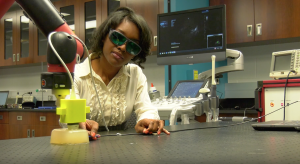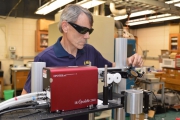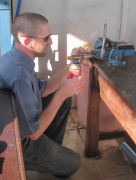Background
Muyinatu Bell is an Assistant Professor and Director of Photoacoustic & Ultrasonic Systems Engineering (PULSE) Lab at Johns Hopkins University. Dr. Bell’s research is highlighted in this YouTube video, created for her recognition as Maryland’s Outstanding Young Engineer.
The PULSE lab is developing the next generation of imaging systems using a combination of optics, acoustics, and robotics. The optics plus acoustics combination is known as photoacoustic (or optoacoustic) imaging. In this relatively novel medical imaging method, laser light is transmitted to a structure of interest, which absorbs the light, undergoes thermal expansion, and generates an ultrasound wave that we detect with clinical ultrasound transducers. Structures of interest in my research include major blood vessels that are hidden by tissue and need to be avoided during surgery, as well as the metal tips of surgical tools. Major blood vessels and tool tips both generate strong photoacoustic signals in comparison to surrounding tissue and can be used to provide surgeons with the information needed to avoid accidental injury, which can lead to excessive bleeding and potentially patient death.
How has the Opotek Laser been helpful in your research?
In the PULSE Lab, we aim to understand fundamental design requirements for photoacoustic imaging systems that can be used to guide surgeries, as well as augment the vision capabilities of robotic surgical systems. Given these equally important and often clinically translatable aspects of my research, we have two Opotek lasers — one located in my lab on the primary engineering campus of Johns Hopkins University (known as the Homewood campus) and one located in my lab space at the Johns Hopkins Hospital. These two campuses are within a 20-minute drive of each other, so the ability to have a laser on each campus enables simultaneous operations and experiments on each campus at any given time without the hassle of packing up and transporting this major equipment component of my research between campuses. Although we do not make laser transportation trips between campuses, we specifically have the Opotek Phocus Mobile for the express purpose of transporting the laser and photoacoustic imaging setup from my lab in the hospital to any operating room in the hospital, where we commonly perform our in vivo experiments. This laser is built for mobility without sacrificing the high energies that we need to explore the limits of this novel application of photoacoustic imaging for surgical guidance. The Phocus Mobile laser is such a delight to transport around the Johns Hopkins Hospital and the stability of the system has thus far been maintained with each trip. My satisfying arrangement with two similar Phocus Mobile lasers has so far enabled the research that is described in the following four recent publications from the PULSE Lab:
- Graham M, Assis F, Allman D, Wiacek A, González E, Gubbi M, Dong J, Hou H, Beck S, Chrispin J, Bell MAL, In vivo demonstration of photoacoustic image guidance and robotic visual servoing for cardiac catheter-based interventions, IEEE Transactions on Medical Imaging (accepted on August 30, 2019) https://ieeexplore.ieee.org/stamp/stamp.jsp?tp=&arnumber=8825818&tag=1
- Kempski K, Wiacek A, Graham M, González E, Goodson B, Allman D, Palmer J, Hou H, Beck S, He J, Bell MAL, In vivo photoacoustic imaging of major blood vessels in the pancreas and liver during surgery, Journal of Biomedical Optics, 24(12):121905, 2019 https://doi.org/10.1117/1.JBO.24.12.121905
- Bell MAL, Shubert J, Photoacoustic-based visual servoing of a needle tip, Scientific Reports, 8:15519, 2018 https://www.nature.com/articles/s41598-018-33931-9
- Allard M, Shubert J, Bell MAL, Feasibility of photoacoustic guided teleoperated hysterectomies, Journal of Medical Imaging: Special Issue on Image-Guided Procedures, Robotic Interventions, and Modeling, 5(2), 021213, 2018 https://doi.org/10.1117/1.JMI.5.2.021213
She looks forward to many more exciting projects like those described in these four publications, thanks to the help, products, and support provided by Opotek!



